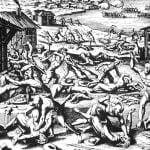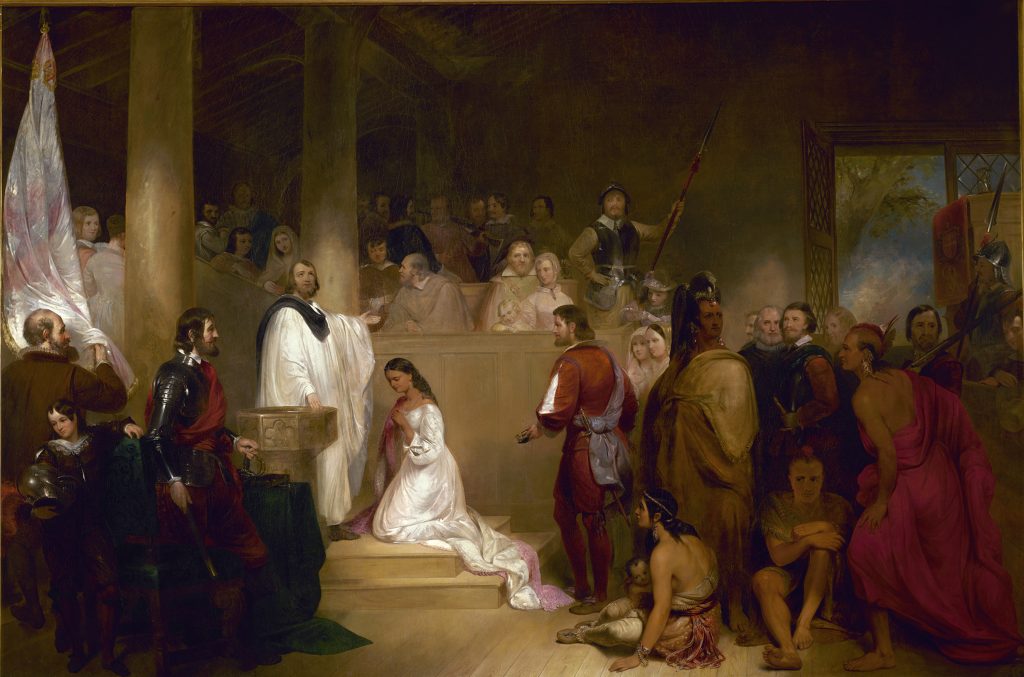The Virginia Massacre of 1622 and of 1641 (or 1644)

The spring of 1622 was memorable for a deep-laid and partially successful plot, attributed in no small measure to the contrivance of Opechancanough, for the extermination of the English colony. The settlers had come to look upon the Indians with a mixture of condescension and contempt; they admitted them freely into their houses; suffered them to acquire the use of English weapons; and took little or no precautions against an outbreak. The plantations and villages of the whites were widely separated and ill-protected, offering an easy opportunity for a sudden and concerted attack.
No suspicions whatever were entertained of any hostile intent upon the part of the savages until just before the massacre commenced, and then there was neither time nor opportunity to convey the intelligence to the distant settlements. The plot was so arranged that upon a day appointed, the 22d of March, the Indians spread themselves throughout the settlements, and, going into the houses, or joining the laborers in the field, on pretense of trade, took the first opportunity to kill those with whom they were communicating, by a blow from behind.
No less than three hundred and forty-seven of the English perished, the most extensive massacre at any one spot being that in Martin’s Hundred, only seven miles from Jamestown. The savages spared not their best friends, with whom they had held amicable intercourse for years, but availed themselves of that very intimacy to carry out their bloody design with the greater secrecy and impunity. One only showed signs of relenting. “The slaughter had been universal if God had not put it into the heart of an Indian, who, lying in the house of one Pace, was urged by another Indian, his brother, that lay with him the night before, to kill Pace as he should do Perry, which was his friend, being so commanded from their king.”

Instead of complying, he rose, and made known to his host the plan of the next day’s attack. Pace carried the intelligence to Jamestown with the utmost expedition, and the caution was spread as far as possible. Wherever the Indians saw the English upon their guard, no attempt was made upon them, even where there was a gross disparity in numbers. One of Smith’s old guard, Nathaniel Causie, after receiving a severe wound, seized an axe, and put those to flight who had set upon him. In another instance, two men repelled the attack of sixty savages, and a Mr. Baldwin, at Warraskoyack, defended his house and its inmates single handed, the Indians being unwilling to stand his fire. Women, children, and unarmed men; all who could be taken unawares, were murdered, and their bodies hacked and mutilated. No tie of friendship or former favor proved strong enough to stay the hand of the remorseless foe. A Mr. Thorp, who had shown every kindness to the Indians, and especially to the king, was one of the victims, his “dead corpse being abused with such spite and scorn as is unfit to be heard with civil ears.” He had formerly built a convenient house for the sachem, “after the English fashion, in which he took such pleasure, especially in the lock and key, which he so admired as locking and unlocking his door a hundred times a day, he thought no device in the world comparable to it.”
It was supposed that the motive which operated most forcibly upon Opechancanough, in urging him to these enormities, was the death of Nemattanow, one of his favorites, styled “Jack of the Feather, because he commonly was most strangely adorned with them.” This Indian was shot, about a fortnight before the massacre, for the murder of a man named Morgan, whom he enticed from home on pretense of trade.
Little active efforts were made to revenge the uprising of the Indians. After the bloody day in March, no general engagement took place between the English and the savages until the ensuing autumn, when an army of three hundred colonists marched to Nandsamund, and laid waste the country.
Death Of Opechancanough

The bitterest animosity prevailed for many years between the rival claimants to the country the Indians and the pale faces, who were supplanting them, insidiously, or by open warfare. The old chief, Opechancanough, remained long a thorn in the sides of the colonists; and, as late as 1641, nine years after the conclusion of a settled peace, he organized a conspiracy, which resulted in the destruction of even a larger number of the whites than fell in the massacre of 1622. The time of the second uprising is fixed, by some, three years later than the date above mentioned.
After that event, the war was pursued with the energy that the dangerous circumstances of the colony required; and the aged chief, falling into the hands of the English, was carried captive to Jamestown. Regard to his infirmities and age restrained the authorities from showing him indignity or unkindness, but he was shot by a private soldier, in revenge, as is supposed, for some former injury. Although so enfeebled by the weight of years as to be utterly helpless, and unable even to raise his eyelids with out assistance, the venerable chief still maintained his dignity and firmness; and, just before his death, rebuked Berkley, the governor, for suffering his people to crowd around and gaze upon him.
It is said by some historians that he was not a native of Virginia, but that he was reputed among his subjects and the neighboring tribes, to have been formerly a king over a nation far to the south-west.


